According to Becky Shea, an interior designer and founder of Becky Shea Design, farmhouse style is as much a lifestyle as it is a design aesthetic. “It’s really about a lifestyle and bringing that simpler, clean aesthetic to a home, and really focusing on what matters the most,” she says. Often defined as chic, comfy, cozy, or warm, it’s a look that’s been made particularly popular in the last decade or so. And while you might recognize it when you see it, understanding the core design elements and principles can help anyone bring this welcoming and homey style into their space. Below, AD talks with Shea and interior designer Kirsten Krason from House of Jade about farmhouse design and bringing this style to life.
What is farmhouse style?
Though there can be some fluidity in forms, farmhouse style is generally separated into two distinct design aesthetics: traditional farmhouses and modern farmhouses. The classic farmhouse look—also known as a traditional farmhouse—is often defined by a more rustic country style, often making use of vintage furniture or familiar patterns like plaid. “Traditional farmhouses definitely take more of that craftsmanship from the craftsman movement,” Shea says. “It’s simpler, flat cut; [it] features unlacquered brass, for example, and [it’s] a little bit more traditionalist.” Deeper colors like burgundy, green, or blue are also common in a more rustic farmhouse style.
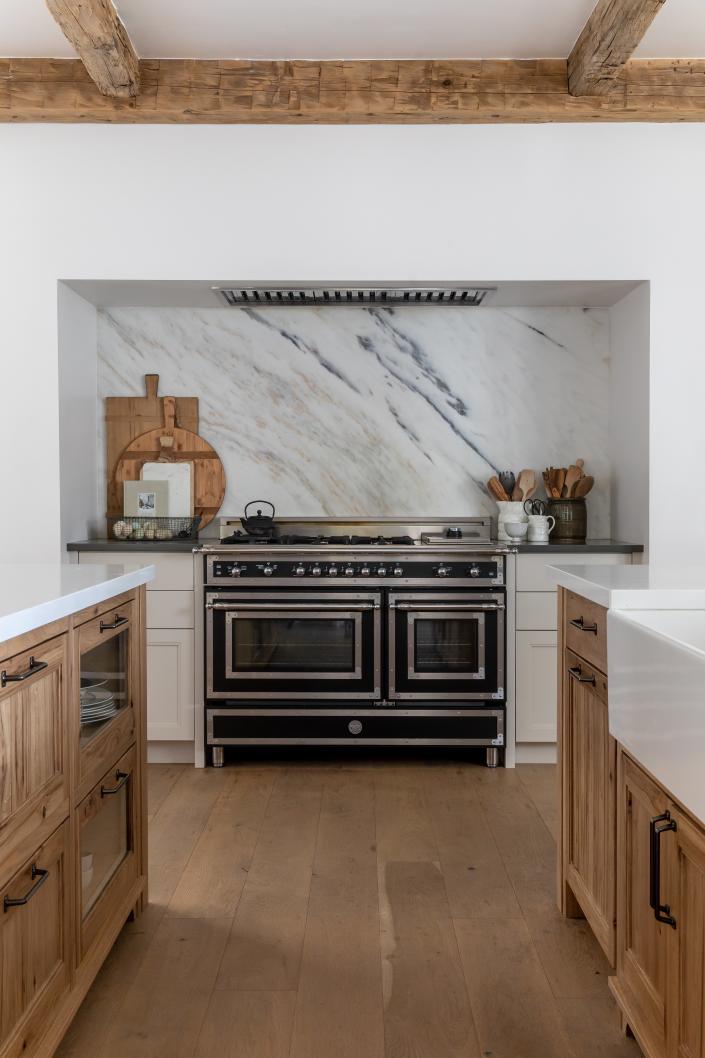
A farmhouse kitchen designed by House of Jade.
Photo: Courtesy of House of Jade.
What is modern farmhouse style?
Modern farmhouse style, as the name suggests, brings more contemporary elements into the aesthetic. “The term modern farmhouse emerged when the farmhouse style first became popular among the masses,” Krason says. “Over the years we have seen this style evolve into differing variations such as a traditional farmhouse, coastal farmhouse, french farmhouse, or modern farmhouse.” Modern farmhouses tend to feel more early American, featuring less intricate finish work and decor. Often, homes with modern farmhouse interiors will make use of clean lines, a more neutral color scheme, and modern finishes. “Modern farmhouses lean a bit more into a Scandinavian form,” Shea adds.
History of farmhouse style homes
True to the name, the farmhouse design style has its roots in actual farmhouses or shelters that were built specifically for farmers. Though homes on farmlands have existed for as long as farmers have, many attribute the traditional farmhouses in Europe from the 16th and 17th centuries as the inspiration for this specific aesthetic. “Over the years the simple farmhouse has evolved into a distinct design style,” Krason says.
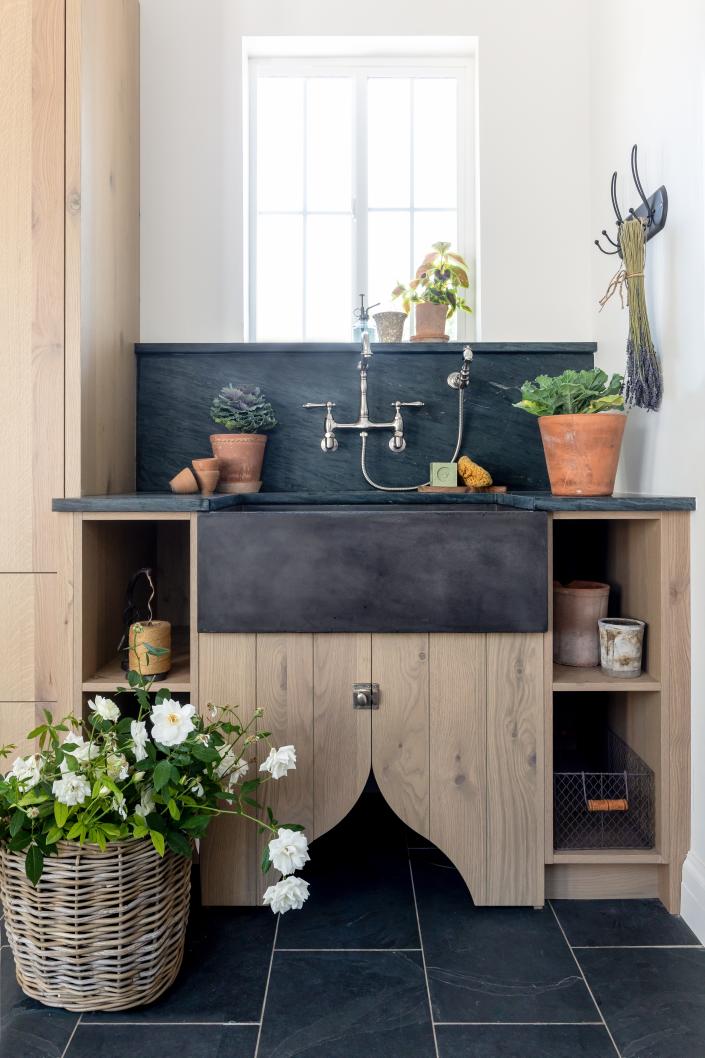
In this sink by House of Jade, rustic elements like aged pots and twine complement modern finishes.
Photo: Courtesy of House of Jade.
As these homeowners were constructing their properties, the homes were often made from readily available materials, like wood or stone, and were designed for both comfort and functionality. Often this meant the homes weren’t large—as most users would spend the majority of their time outdoors—but were welcoming after a long day of work.
Today, both traditional farmhouse style homes and modern farmhouse style homes pull from these original elements. Traditional farmhouse homes will often embrace the more rustic elements of these homes and, in many ways, it can be seen as a progression of an aesthetic through the decades.
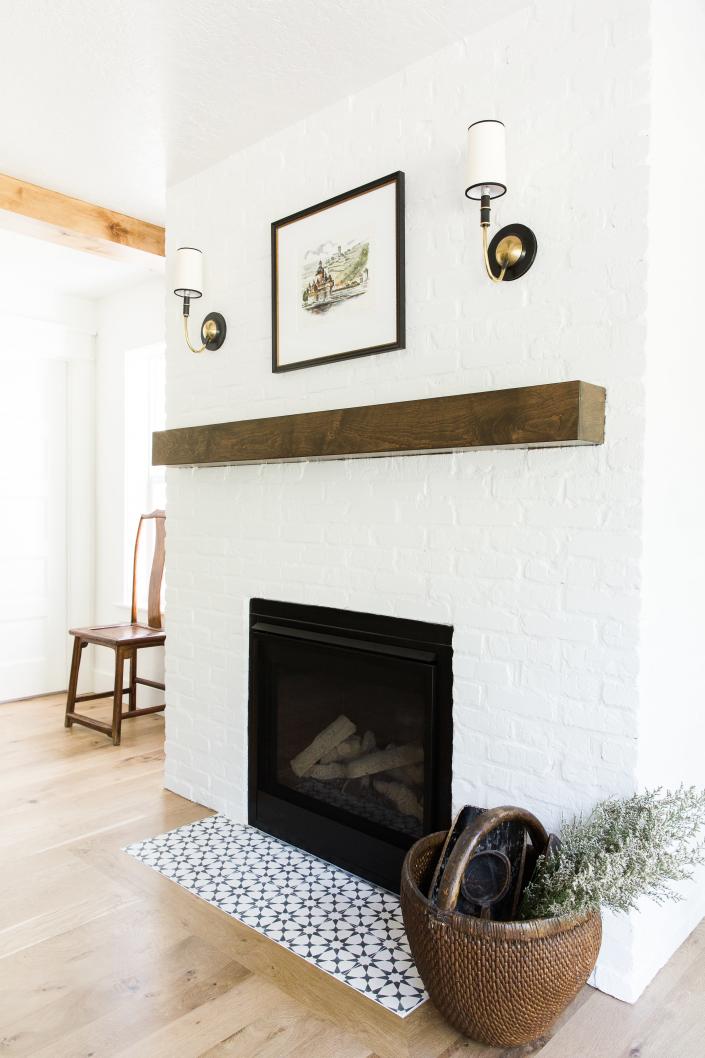
Fireplaces are often focal points in farmhouse design, and usually make use of brick or stone like this one by House of Jade.
Photo: Travis J Photography. Courtesy of House of Jade.
Modern farmhouse style, on the other hand, is largely credited to Joanna Gaines and the debut of Fixer Upper in 2013. Her unique style made use of certain traditional farmhouse elements, such as exposed beams or shiplap paneling, but with contemporary upgrades—like modern wood floors or appliances—and a more neutral color palette, with accent colors usually reserved to darker blues or greens. Though she may not have been the only designer working in this style, the show has been a large factor in bringing the style to the masses.
Defining characteristics and elements of farmhouse style

A large modern farmhouse kitchen designed by Becky Shea features a large dark blue island.
Photo: Jake Shea
Like any interior design aesthetic, there’s no one way to do farmhouse style. However, when it comes to farmhouse style, many homes make use of some combination of the following elements:
-
Exposed wood beams
-
A neutral color palette
-
Plants and greenery as accents
-
Vintage or antique accent pieces
-
Shiplap paneling
-
Large, comfortable furniture
-
Barn doors
-
Reclaimed wood
-
Open shelving
-
Ample cabinetry
What makes a house farmhouse style?

Wood beams are used extensively in farmhouse style design.
Photo: Travis J Photography
When it comes to home design, there are certain architectural details that are frequently seen on farmhouse style homes. For those working on a ground-up project, Shea says the shape of the house is often the most important. “Make sure you build something that emulates a farmhouse, which is typically a flat face or a ranch-style home, which are long and linear” she says. The interior designer also recommends “going back to grassroots” when it comes to property’s materials, suggesting people opt for organic elements or items already in circulation. “Farmhouses were all about utilitarianism and using the means of the land,” she says. “So I think it’s important to incorporate that if you are going to embody this architectural style.”
What makes decor farmhouse style?
Of course, for those not looking to build new or do a large remodel, there are still ways to add farmhouse charm to your home, mainly through a decorative makeover. Generally, it’s no one piece of decor or furniture that is specifically designed in a farmhouse style, but rather an ethos that emerges when multiple pieces are paired together. Just because something is, say, neutral colored doesn’t automatically mean it’s a farmhouse item. A piece like that could just as easily fit into a midcentury aesthetic, for example, or a minimalist one.
For a modern farmhouse look, it’s good to pair neutral-colored and relatively simple items with a few rustic touches. For example, a modern farmhouse living room could be defined by a large, comfortable white sofa, a simple coffee table made from a natural wood like pine or birch, and exposed wooden beams for additional visual interest. A traditional farmhouse could also include similar items, but often with a more liberal use of patterns, color, and vintage pieces.
Design ideas and examples of farmhouse style homes and decor
Farmhouse living rooms
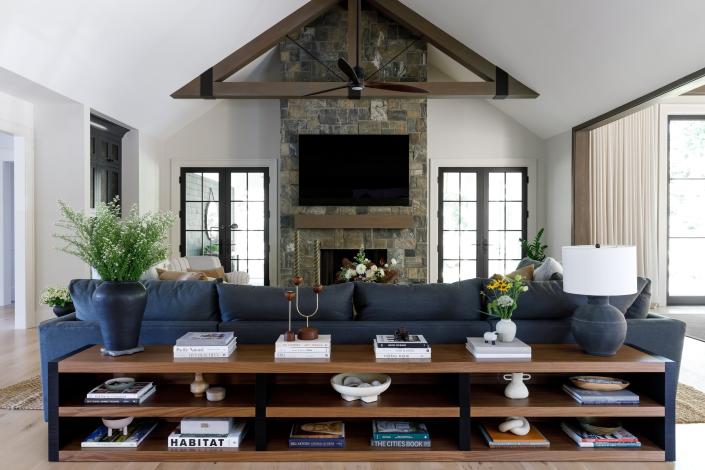
This farmhouse-style living room by Becky Shea incorporates large, comfy furniture, exposed beams, and a stone fireplace.
Photo: Jake Shea

Another farmhouse-style living room by House of Jade features a more neutral color palette with pops of color from plants.
Photo: Courtesy of House of Jade.
Farmhouse kitchens

Shiplap is a common element in farmhouse homes, as is open shelving.
Photo: Jake Shea

A farmhouse kitchen by House of Jade includes charming black and white tiles and a green cabinetry.
Photo: Travis Richardson. Courtesy of House of Jade.
Farmhouse bedrooms
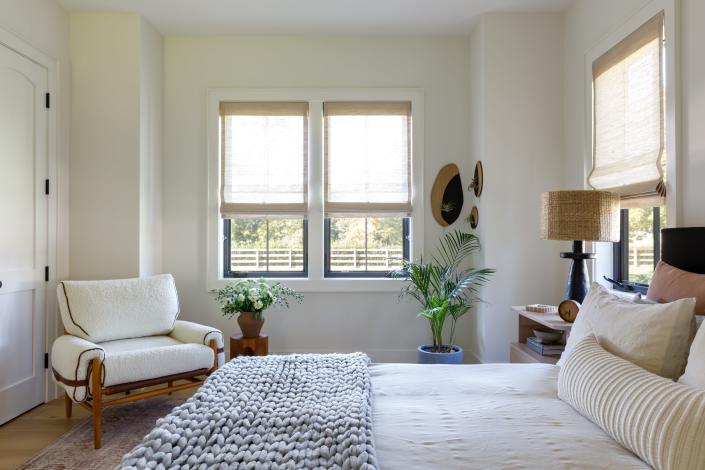
Farmhouse bedrooms are often fairly neutral, like this one by Becky Shea.
Photo: Jake Shea
Farmhouse dining rooms
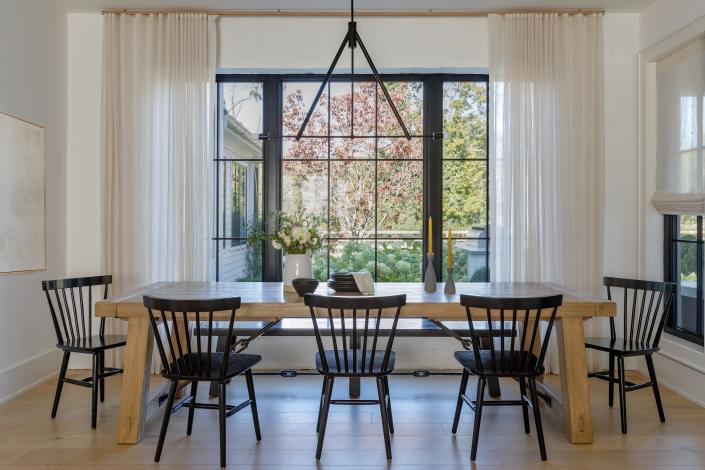
Ample seating for gathering and conversation is a common element seen in farmhouse dining rooms.
Photo: Jake Shea
Farmhouse bathrooms

A freestanding tub in a minimal bathroom makes for a chic space to relax.
Photo: Travis J Photography. Courtesy of House of Jade.

Becky Shea also used a freestanding tub in this bathroom design.
Photo: Jake Shea
How to achieve farmhouse style
For those interested in integrating farmhouse style into their homes, there are plenty of solutions—and some are even DIY friendly. Krason says a good place to start is by considering your local geography. “If you are in the mountains, incorporate rustic woods and stones,” she says. “If you live by the beach, add in blues and greens.” For homes on the East Coast, she says considering a symmetrical exterior, crown molding, and detailed fireplaces can help emulate a colonial farmhouse and be appropriate for the region. “I think a ceiling application using reclaimed wood is a really easy way to get the look,” Shea says, adding that using a limewash paint or redoing a fireplace with repurposed brick could also be useful decor ideas. “And then it’s really just about layers, so lots and lots of blankets and pillows,” she says.
Is farmhouse style still in?
These days, farmhouse style is still overwhelmingly popular; in fact, it was one of the most searched decor styles in 2022. “If you are incorporating the classic elements of a farmhouse into your home, you won’t have to worry about it being out of style in a few years,” Krason says. “The classic elements are things that make any home last the test of time. [They] would include wood beams, marble, detailed classical trim used in moderation, and simple, not overly complicated decorating.”
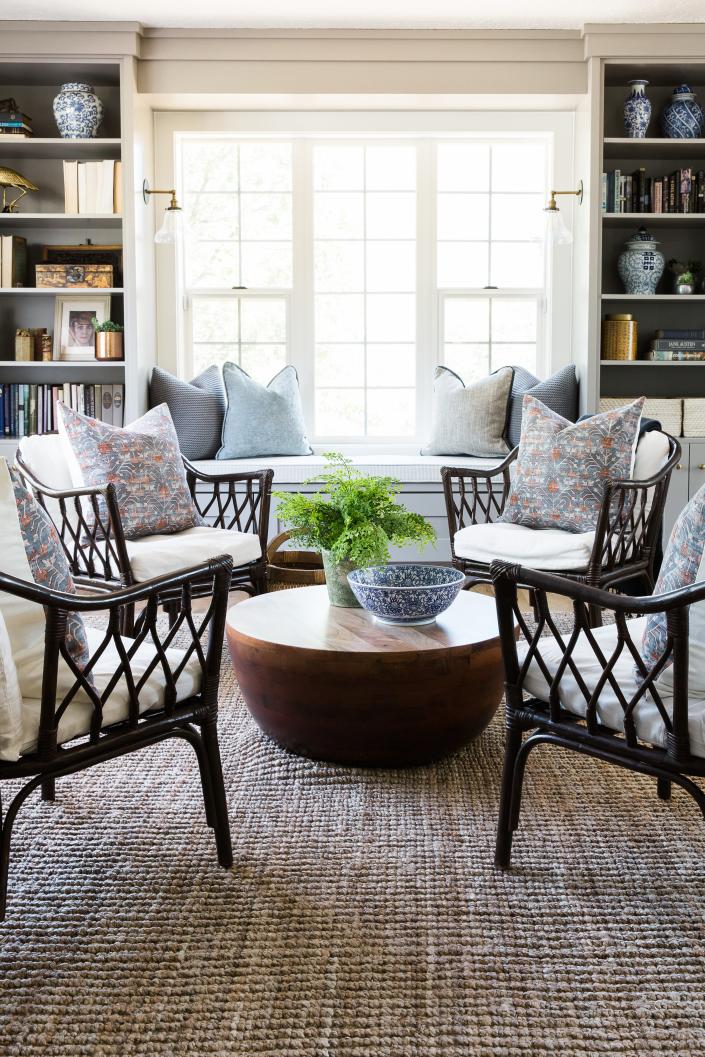
A modern farmhouse seating area makes use of a textured rug and open shelving.
Photo: Travis J Photography. Courtesy of House of Jade.
And though most design professionals would encourage people to follow their own tastes—whether something is in vogue or not—it’s not uncommon to wonder about the realistic lifespan of something as permanent as your home’s design. Though Krasson assures the aesthetic won’t feel dated anytime soon, another way to approach the question is to consider the values that the look emulates. Shea says that her clients who are most eager to embrace this look are drawn to its ability to be equally durable and utilitarian as it is elevated and sophisticated. “Life in general has become so chaotic in the past few years,” she says. “And I think people are looking for something that’s simpler, more practical, and functional, and this is definitely an aesthetic that I think lends itself to that.” Though no one can predict the future, it’s unlikely these intrinsic needs will go out of fashion soon—and even if they do, the look is still on the table if it’s something you enjoy.
Originally Appeared on Architectural Digest






